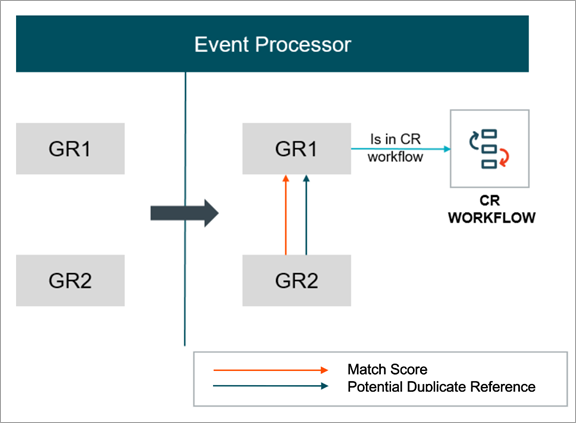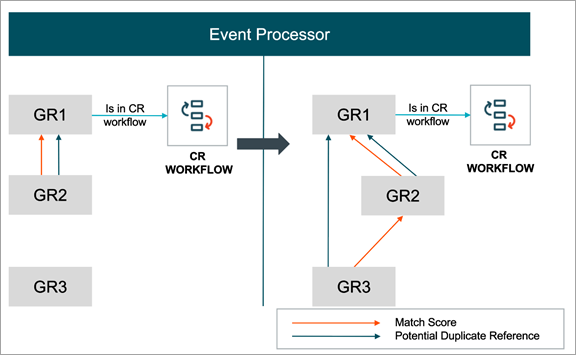In a Match and Merge match action solution, the match score can be stored on a Potential Duplicate Group Reference Type.
STEP matching algorithms use match criteria which produce match scores to quantitatively measure the likeness of two golden records. This likeness may result in Clerical Review tasks, which can materialize as potential duplicate group references. The match scores between a potential duplicate group and a workflow node can be stored on that reference.
Important: Clerical Review Task Lists can function even without a Potential Duplicate Group Reference Type clarified in the Matching - Merge Golden Record component model; however, it will be much less stable and could result in errors. For more information, refer to the topic Configuring the Matching - Merge Golden Record Component Model.
While it is not a comprehensive list, the following sections include examples of how golden records might link as potential duplicate groups produce match scores when a new golden record is matched with an existing one.
New Record Match with Neither in a Workflow
The following scenario represents when two golden records are compared as potential duplicate groups when neither is in a Clerical Review workflow.

-
One of the records is edited (e.g. a user adds a phone number) or created.
-
The event processor acknowledges the change and initiates the matching algorithm; it finds a shared match code between GR1 and GR2.
-
GR1 and GR2 are compared and receive a match score within the clerical review threshold.
-
The event processor creates a new task and links the two records with a potential duplicate group reference. For easy searching, a potential duplicate group reference is also added from GR2 to GR1 when the task is created.
-
GR1 is now in the Clerical Review workflow, GR2 now references GR1 with a Potential Duplicate Group Reference Type, and the match score is saved as metadata on the potential duplicate group reference.
New Record Match to an Existing Potential Duplicate Group
The following scenario represents when a third golden record is introduced and compared to two already matched golden records.

-
A user updates GR3, which now shares a match code with GR1.
-
The event processor acknowledges the update to GR3 and initiates the matching algorithm; it finds a shared match code between GR1 and GR3.
-
GR1 and GR3 are compared and receive a match score within the Clerical Review threshold.
-
The event processor identifies the existing task and links the GR3 to GR1 with a potential duplicate group reference.
GR1 now shares a potential duplicate group reference with both GR2 and GR3. The match scores for both are saved as metadata on their respective potential duplicate group references.
New Indirect Match to an Existing Potential Duplicate Group
The following scenario represents when a third golden record is introduced and matches with another potential duplicate group (GR2), but not with the workflow node (GR1).

-
A user updates GR3, which now shares a match code with GR1.
-
The event processor acknowledges the update to GR3 and initiates the matching algorithm; it finds a shared match code between GR2 and GR3.
-
GR2 and GR3 are compared and receive a match score within the Clerical Review threshold range.
-
The event processor identifies the existing task and links GR3 to GR1 with a potential duplicate group reference. There is no potential duplicate group reference between GR2 and GR3, and no match score between GR1 and GR3.
-
GR1 now shares a potential duplicate group reference with both GR2 and GR3. As there is no match code shared between GR3 and GR1, they receive no match score. GR3 is only indirectly included in the review. This is indicated in the Clerical Review Task List by an 'N/A' displaying, instead of a match score.